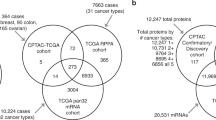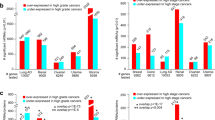Abstract
In this paper, we briefly review cancer proteomics in general, with particular attention to our proteome analyses of prostate cancer. Our efforts include development of new tools and novel approaches to discovering proteins potentially useful as cancer diagnostic and/or prognostic biomarkers or as therapeutic targets. To this end, we analyzed prostate cancer proteomes using two-dimensional gel electrophoresis employing agarose gels for the initial isoelectric focusing step (agarose 2-DE), with mass spectrometry used for protein identification. Agarose 2-DE offers advantages over the more widely used immobilized pH gradient 2-DE for separating high molecular mass proteins (15–500 kDa), thereby increasing its power to detect changes in the cancer's high-molecular mass proteomes.
This is a preview of subscription content, access via your institution
Access options
Subscribe to this journal
Receive 4 print issues and online access
$259.00 per year
only $64.75 per issue
Buy this article
- Purchase on Springer Link
- Instant access to full article PDF
Prices may be subject to local taxes which are calculated during checkout




Similar content being viewed by others
References
Wilkins MR et al. From proteins to proteomes: large scale protein identification by two-dimensional electrophoresis and amino acid analysis. Biotechnology (NY) 1996; 14: 61–65.
Klose J, Kobalz U . Two-dimensional electrophoresis of proteins: an updated protocol and implications for a functional analysis of the genome. Electrophoresis 1995; 16: 1034–1059.
O'Farrell PH . High resolution two-dimensional electrophoresis of proteins. J Biol Chem 1975; 250: 4007–4021.
Figeys D, Ducret A, Yates III JR, Aebersold R . Protein identification by solid phase microextraction–capillary zone electrophoresis–microelectrospray–tandem mass spectrometry. Nat Biotechnol 1996; 14: 1579–1583.
Aebersold R, Mann M . Mass spectrometry-based proteomics. Nature 2003; 422: 198–207.
Wang H, Hanash S . Multi-dimensional liquid phase based separations in proteomics. J Chromatogr B Analyt Technol Biomed Life Sci 2003; 787: 11–18.
Ferrari L et al. Protein profiles in sera of patients with malignant cutaneous melanoma. Rapid Commun Mass Spectrom 2000; 14: 1149–1154.
MacBeath G . Protein microarrays and proteomics. Nat Genet 2002; 32: 526–532.
Issaq HJ, Veenstra TD, Conrads TP, Felschow D . The SELDI-TOF MS approach to proteomics: protein profiling and biomarker identification. Biochem Biophys Res Commun 2002; 292: 587–592.
Merchant M, Weinberger SR . Recent advancements in surface-enhanced laser desorption/ionization-time of flight-mass spectrometry. Electrophoresis 2000; 21: 1164–1177.
Patton WF . Detection technologies in proteome analysis. J Chromatogr B Analyt Technol Biomed Life Sci 2002; 771: 3–31.
Gygi SP et al. Quantitative analysis of complex protein mixtures using isotope-coded affinity tags. Nat Biotechnol 1999; 17: 994–999.
Figeys D, van Oostveen I, Ducret A, Aebersold R . Protein identification by capillary zone electrophoresis/microelectrospray ionization–tandem mass spectrometry at the subfemtomole level. Anal Chem 1996; 68: 1822–1828.
Wilm M et al. Femtomole sequencing of proteins from polyacrylamide gels by nano-electrospray mass spectrometry. Nature 1996; 379: 466–469.
Oh-Ishi M, Satoh M, Maeda T . Preparative two-dimensional gel electrophoresis with agarose gels in the first dimension for high molecular mass proteins. Electrophoresis 2000; 21: 1653–1669.
Zhou G et al. 2D differential in-gel electrophoresis for the identification of esophageal scans cell cancer-specific protein markers. Mol Cell Proteomics 2002; 1: 117–124.
Vihinen M . Bioinformatics in proteomics. Biomol Eng 2001; 18: 241–248.
Hirabayashi T . Two-dimensional gel electrophoresis of chicken skeletal muscle proteins with agarose gels in the first dimension. Anal Biochem 1981; 117: 443–451.
Oh-Ishi M, Maeda T . Separation techniques for high molecular mass proteins. J Chromatogr B Analyt Technol Biomed Life Sci 2002; 771: 49–66.
Jemal A et al. Cancer statistics, 2003. CA Cancer J Clin 2003; 53: 5–26.
Chan DW, Sokoll LJ . Prostate-specific antigen: update 1997. J Int Fed Clin Chem 1997; 9: 120–125.
Partin AW, Oesterling JE . The clinical usefulness of percent free-PSA. Urology 1996; 48: 1–3.
Crawford ED, DeAntoni EP, Ross CA . The role of prostate-specific antigen in the chemoprevention of prostate cancer. J Cell Biochem Suppl 1996; 25: 149–155.
Grover PK, Resnick MI . Analysis of prostatic fluid: evidence for the presence of a prospective marker for prostatic cancer. Prostate 1995; 26: 12–18.
Grover PK, Resnick MI . High resolution two-dimensional electrophoretic analysis of urinary proteins of patients with prostatic cancer. Electrophoresis 1997; 18: 814–818.
Partin AW et al. Nuclear matrix protein patterns in human benign prostatic hyperplasia and prostate cancer. Cancer Res 1993; 53: 744–746.
Alaiya A et al. Polypeptide expression in prostate hyperplasia and prostate adenocarcinoma. Anal Cell Pathol 2000; 21: 1–9.
Alaiya AA et al. Identification of proteins in human prostate tumor material by two-dimensional gel electrophoresis and mass spectrometry. Cell Mol Life Sci 2001; 58: 307–311.
Xiao Z et al. Quantitation of serum prostate-specific membrane antigen by a novel protein biochip immunoassay discriminates benign from malignant prostate disease. Cancer Res 2001; 61: 6029–6033.
Cazares LH et al. Normal, benign, preneoplastic, and malignant prostate cells have distinct protein expression profiles resolved by surface enhanced laser desorption/ionization mass spectrometry. Clin Cancer Res 2002; 8: 2541–2552.
Petricoin III EF et al. Serum proteomic patterns for detection of prostate cancer. J Natl Cancer Inst 2002; 94: 1576–1578.
Adam BL et al. Serum protein fingerprinting coupled with a pattern-matching algorithm distinguishes prostate cancer from benign prostate hyperplasia and healthy men. Cancer Res 2002; 62: 3609–3614.
Qu Y et al. Boosted decision tree analysis of surface-enhanced laser desorption/ionization mass spectral serum profiles discriminates prostate cancer from noncancer patients. Clin Chem 2002; 48: 1835–1843.
Banez LL et al. Diagnostic potential of serum proteomic patterns in prostate cancer. J Urol 2003; 170: 442–446.
Griffin TJ et al. Abundance ratio-dependent proteomic analysis by mass spectrometry. Anal Chem 2003; 75: 867–874.
Hawkins V et al. PEDB: the prostate expression database. Nucleic Acids Res 1999; 27: 204–208.
Nelson PS et al. Comprehensive analyses of prostate gene expression: convergence of expressed sequence tag databases, transcript profiling and proteomics. Electrophoresis 2000; 21: 1823–1831.
Davila M, Frost AR, Grizzle WE, Chakrabarti R . LIM kinase 1 is essential for invasive growth of prostate epithelial cells. J Biol Chem 2003; 278: 36868–36875.
Moul JM, Merseburger AS, Srivastava S . Molecular markers in prostate cancer: the role in preoperative staging. Clin Prostate Cancer 2002; 1: 42–50.
Gygi SP, Rochon Y, Franza BR, Aebersold R . Correlation between protein and mRNA abundance in Yeast. Mol Cell Biol 1999; 19: 1720–1730.
Waghray A et al. Identification of androgen-regulated genes in the prostate cancer cell line LNCaP by serial analysis of gene expression and proteomic analysis. Proteomics 2001; 1: 1327–1338.
Acknowledgements
We thank WA Thomasson, PhD, for expert editorial assistance. This work was supported by Grant-in-Aid for Scientific Research on Priority Areas ‘Medical Genome Science’ from the Ministry of Education, Culture, Sports, Science and Technology of Japan.
Author information
Authors and Affiliations
Corresponding author
Rights and permissions
About this article
Cite this article
Kuruma, H., Egawa, S., Oh-Ishi, M. et al. Proteome analysis of prostate cancer. Prostate Cancer Prostatic Dis 8, 14–21 (2005). https://doi.org/10.1038/sj.pcan.4500764
Received:
Revised:
Accepted:
Published:
Issue Date:
DOI: https://doi.org/10.1038/sj.pcan.4500764
Keywords
This article is cited by
-
High expression of HSP47 in ulcerative colitis-associated carcinomas: proteomic approach
British Journal of Cancer (2009)



